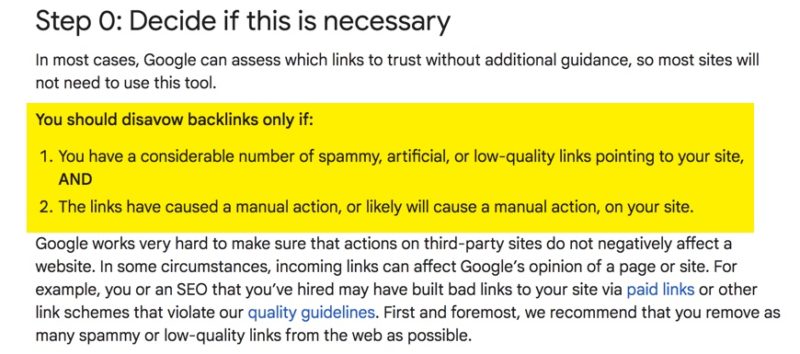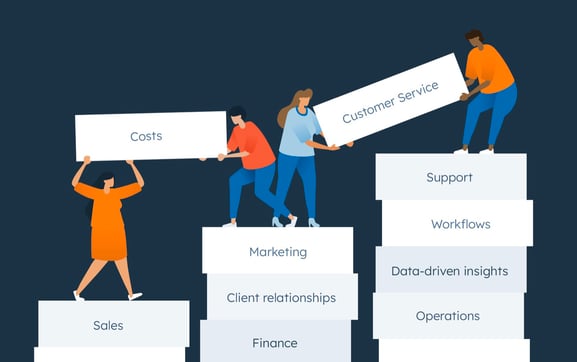What is a toxic link? Are toxic links the same thing as spammy links? Can too many of these hurt your site’s ability to rank?
If you are uncertain as to whether you would benefit from filing a disavow, this article should answer your questions.
What is a toxic link?
A “toxic” link is generally considered to be a link that has the potential to harm your website’s ability to rank. However, not all SEOs are aligned on how to define toxic links and whether their presence actually could hurt your ability to rank.
Some will say that any link that would be considered an unnatural link as per Google’s documentation on link schemes should be considered “toxic” and could hurt your site. Others use the phrase to describe the type of spammy link that Google says their algorithms ignore.
It is important to note that Google itself does not actually have a notion of “toxic links”.
So why do SEOs use the phrase “toxic links”?
Several well-known SEO tools aim to find and help you disavow unnatural links. Several of them list links that they have programmatically determined to be potentially harmful in Google’s algorithms.
The idea is that you can use their tools to identify these “toxic links” that could potentially hurt your site, and then disavow them.
I believe these tools are attempting to find all unnatural links pointing to your site. But in my experience, the majority of links that are returned by these tools are ones that I would consider spammy or “cruft”. Most of these really should be ignored by Google’s algorithms.
I find that the truly toxic links…the ones that could have the potential to harm your site algorithmically (although you’d have to really overdo it, as I’ll describe below), are rarely returned by an SEO tool.
Before we go further, let’s define three terms I’ll be using throughout the remainder of this article:
- Toxic links: Links a tool has identified as being potentially harmful to your site.
- Spammy links: The type of link no one would actually purposefully make in order to improve rankings but most sites accrue. Examples include links from sites that publish domain stats, random foreign language gibberish pages, wallpaper image site links, and sites like theglobe.net that link out to almost every site on the web. Spammy links could also include onslaughts of low-quality links in negative SEO attacks.
- Manipulative links: Links that have been made with the intention of manipulating PageRank to improve Google rankings. Examples include paid links, links in articles for SEO, and other schemes that are designed primarily to boost PageRank and subsequently, rankings.
There can be some crossover between these definitions, which adds to the confusion. Google recently called some links in guest posts and affiliate marketing posts as potentially being seen as both spammy and manipulative (keep reading for more details about this).
Can spammy links hurt your ability to rank on Google search?
If you have links pointing to your site, there’s a good chance that many of them are spammy links. Every site that has links pointing to it collects odd, junky links that don’t make sense.
In the vast majority of cases, spammy links pointing at a site will not harm the site’s ability to rank. There is some disagreement on this though, which I will address shortly.
I call most of these spammy links, “cruft” links. These would include things like links from sites that publish domain stats, random mentions on image wallpaper sites, or even influxes of odd foreign language links or ones with adult or pharmacology keywords as anchors.
When Google’s John Mueller was asked about spammy links, specifically those from sites like theglobe.net, he said,
“We already ignore links from sites like that, where there are unlikely to be natural links. No need to disavow.”
Google’s John Mueller

Google knows that if your site suddenly receives an influx of unusual spammy links anchored with adult terms, for example, it is unlikely that you have been building these to try and improve your search results. In most cases, they can simply isolate these odd, useless links and ignore them in their algorithms.
Prior to the release of Penguin 4.0 in 2016, a large number of spammy links potentially could impact a site’s ability to rank. We used to recommend disavowing every single spammy link we could find. But in 2016, things changed so that Google now devalues spammy links rather than penalizes a site because of them.
It is important to note that recent Google documentation speaks of some types of spammy links that actually are self-made attempts at manipulation, as opposed to just junk, cruft links.
The July 2021 link spam update was meant to “lessen the impact of link spam” in Google’s ranking system, especially when they see “sites intentionally building spammy links with the intent of manipulating ranking”. Google talked about some specific types of links that they would consider “spam” and not want to count in their algorithms. These links are indeed the type that many SEOs still do make in an attempt to manipulate rankings:
- Affiliate links that aren’t either nofollowed or qualified with rel=”sponsored”.
- Links in guest post campaigns that are “primarily intended to gain links”.
If you saw declines in rankings following the July 2021 link spam update, it is possible that Google’s algorithms have detected you have been building links of this type and isolated them and nullified them in their algorithms. As the documentation says, “Sites taking part in link spam will see changes in Search as those links are re-assessed by our algorithms.”
It is important to note that Google does not say that pages will be demoted or penalized for link spam. In most cases, when link spam is detected, it is isolated by Google and ignored in their algorithms.
This can feel like a demotion though.
If you had a bunch of guest post links that used to help a page rank better, and Google detects these as spam and devalues them, then those rankings will decline. This means the page has lost the ranking boost from links that used to be seen as valid recommendations but no longer are. Disavowing those links probably will not help you see improvements.
While algorithmic demotions for manipulative link building can happen, they are reserved for sites that have severely overdone it to the point where Google’s algorithms struggle to determine which links are worth counting and which are manufactured for SEO purposes. We’ll cover more about this shortly.
Do you need to disavow spammy links?
“Spammy” links, often called “toxic links” by the SEO community and some SEO tools, are unlikely to have a negative impact on your site’s ability to rank. Google’s algorithms are good at identifying which links can be ignored. See these tweets from Mueller:
As Mueller said in a March 2021 Google help hangout:
“Most websites do not need to worry about toxic links. It’s something that our systems, when they run across links that they think are bad, we will primarily ignore them.”
Google’s John Mueller
Also in the same hangout:
“If you’re seeing individual links that pop up and you say, oh this looks like a spammer dropped the link or whatever, I would completely ignore those…..they happen to every website and Google’s system has seen them so many times over the years and we’re very good at just ignoring.”
Google’s John Mueller
(Emphasis mine.)

Despite Mueller’s advice, there are still some in the SEO community who believe that there is value in disavowing spammy links, or even cruft junk links. I have had SEOs whom I trust, share with me that they have disavowed based on recommendations made by an automated link auditing tool and feel that they have seen improvements.
While I still believe that there is very little value in filing a disavow made up of mostly spammy links, two recent polls showed that there is still a significant portion of SEOs who regularly disavow this type of link.
I tweeted asking the SEO community for published case studies showing that disavowing based on automated tools has helped a site. At the time of publishing, there have been no responses.
If you are an SEO who feels you have indeed helped a site by filing a disavow created by an automated tool, please do respond in that tweet thread. If you have good data to publish showing that disavowing spammy links has helped, you can reach out to me and I’d be happy to review it for you and help you publish if I can.
I still think that the majority of disavow work that is done by SEOs is unnecessary.
At my company, we do a lot of link audits and disavow work, and have done it for 10 years now. In the last year, we have had two cases where we disavowed mostly low quality, spammy links, and saw some very mild increase in GSC impressions that started within a week or so of filing. Neither of the increases was dramatic. Neither resulted in meaningful increases in rankings or traffic.
While we would love to take on more work disavowing spammy link profiles, we do not feel that it is a practice that has good ROI. As I’ll explain further on in this article, there are some sites for which we still recommend disavow work. These are the ones where there are obvious signs of link building with the intention of manipulating PageRank.
What about “manipulative links”? Do you need to disavow them?
If Google’s algorithms are so good at isolating spammy links and ignoring them in their algorithms, then why would anyone need to use the disavow tool? Why ask Google to ignore links that they are already ignoring?
There are two situations where we will recommend to our clients a thorough link audit followed by filing a disavow:
- The site has a manual action for unnatural links in GSC.
- The site has a very large number of links that we feel the webspam team would consider to be “manipulative”.
Google’s documentation on whether you should disavow is quite clear.

“You should disavow backlinks only if:
You have a considerable number of spammy, artificial, or low-quality links pointing to your site, AND
The links have caused a manual action, or likely will cause a manual action, on your site.”
Google Help Center: Disavow links to your site
Spammy links alone will not cause you a manual action. Manual actions is for sites that “have been … tricking their way to the top of the results page.”
Should your site get a manual review, the webspam team knows that you didn’t make thousands of links anchored with adult phrases to try and rank better for your (non-adult) terms. They know that foreign language sites that scrape Alexa and republish the info along with a link to your site are not links that you made to manipulate rankings.
A manipulative link is not necessarily the same as a spammy one.
A manipulative link is one that you have made so that you can increase your PageRank. Now, some may argue, “Isn’t this the point of all link building? To improve PageRank?” Google’s own SEO starter guide tells us that promoting our content can be a good thing:
“While most of the links to your site will be added gradually, as people discover your content through search or other ways and link to it, Google understands that you’d like to let others know about the hard work you’ve put into your content. Effectively promoting your new content will lead to faster discovery by those who are interested in the same subject.”
– Google’s Search Engine Optimization (SEO) Starter Guide
But they caution, “As with most points covered in this document, taking these recommendations to an extreme could actually harm the reputation of your site.”
In their documentation on link schemes Google says:
“Any links intended to manipulate PageRank or a site’s ranking in Google search results may be considered part of a link scheme and a violation of Google’s Webmaster Guidelines.”
There is a big difference between inviting others to link to your content and creating your own links on a massive scale with the intention of manipulating PageRank.
If you’ve occasionally dabbled in guest posting specifically for links or getting articles published containing a link back to your site, you’re unlikely to be headed for a manual action. But if you have done a large amount of linking to boost PageRank and you are struggling to gain any traction, in some cases a thorough link audit followed by filing a disavow can help.
There are some situations where Google can algorithmically suppress a site, even in the age of Penguin 4.0 and in these rare cases of extreme manipulation, we have found a thorough disavow helpful. We’ll come to that shortly, along with some examples.
Here are some of the more common types of “manipulative” link patterns that we tend to see today:
- Guest posting primarily for links rather than exposure/brand building.
- Getting articles published on other sites that contain a link back to yours.
- Paying for links to be inserted in content.
If you have done a significant amount of link building in the past, it is possible that these links are impeding your ability to rank to your full potential. This is even more likely if you have a mix of self-made links and truly earned links that make it hard for Google to determine which are which.
Does disavowing actually do anything these days?
Disavowing spammy or toxic links is unlikely to help a site see meaningful improvements. But what about disavowing “manipulative” links that were created to improve a site’s PageRank?
In 2019, I asked Mueller about whether disavowing links could help a site algorithmically. He said:
“That can definitely be the case. So, it’s something where our algorithms when we look at it and they see, oh, there are a bunch of really bad links here. Then maybe they’ll be a bit more cautious with regards to the links in general for the website. So, if you clean that up, then the algorithms look at it and say, oh, there’s – there’s kind of – It’s okay. It’s not bad.”
In October 2021, Mueller was asked about the Penguin algorithm and whether unnatural links were simply ignored by Google now. He said that if Google’s algorithms, in particular, Penguin, determined there was clearly link manipulation in place, they may choose to distrust the entire site:
“Penguin can both ignore links and demote sites, if necessary….if our systems recognize that they can’t isolate and ignore these links across a website.” Mueller added that if Google can see a “very strong pattern there” the Google algorithms can lose “trust with this website” and you may see a “drop in the visibility there.”
Google’s John Mueller
(Emphasis mine.)
In my experience, it is uncommon to see the type of case where there is so much manipulation that Google can’t tell what is good from what should be ignored.
The cases where we do feel that we’ve seen improvement after disavowing, are sites that had link profiles that were a mixture of good natural mentions and a large number of self-made links for SEO – usually links inserted within articles published on other sites.
I’ll share some examples with you of sites that we feel have improved after we disavowed large numbers of links made solely for SEO purposes. However, it is important to note that we cannot conclusively say that disavow work was what helped these sites.
It is rare that we do only disavow work for our clients. These sites have worked on improving quality in many other ways, including E-A-T, technical SEO, site structure and content.
Below is Google organic traffic for a site that came to us with a manual action. It was very difficult to remove because this site had a large number of links that truly were earned recommendations mixed in with a large number of links in articles that were primarily published to increase PageRank.
Identifying which were likely to be seen as manipulative was challenging. This makes sense because if it was easy to identify which links were made just for SEO and which were earned links worth counting, Google’s algorithms could likely do this, and ignore the unnatural links, and no manual action would be necessary!
When this site’s manual action was removed (which took us a long time to accomplish because of the mixture of good vs. unnatural links) there was clearly an uptick in organic traffic. However, this site has also benefited from increased popularity on their topic recently so, while we think the removal of the manual action helped tremendously, we can’t say with certainty that disavow work is the reason for this site’s success.

For the site pictured below, we identified and disavowed hundreds of what we call internally “articles for links”. These are articles that were created just for SEO and shipped out to other websites for publishing…the very definition of manipulative linking. This is unfortunately a very common practice still, despite it clearly being against Google’s guidelines.
This Search Engine Land article explains much more about why you should not be using article campaigns for link building.
This site is seeing beautiful improvements in rankings, traffic, and most importantly revenue since disavowing. But once again, we cannot say with certainty that the disavow work is why. They also have been improving E-A-T in many ways as per our recommendations and working on content improvements as well.

If you are still unsure whether there could be a benefit for you in disavowing, at the end of this article I have laid out some criteria that may help you decide.
In my experience, most of the automated tools that are designed to help site owners find links to disavow are good at finding spammy/toxic links. They are not good at finding truly manipulative links.
If we believe Google when they say they ignore the spammy links, then we can see why simply disavowing the toxic links a tool lists may not accomplish much.
If Google’s powerful algorithms cannot easily find and isolate the manipulative links pointing to a website, then it’s unlikely that a third-party tool is going to be able to do so.
I think that some of the tools that offer automated link auditing solutions can be helpful when it comes to finding links pointing to your site and helping you organize a spreadsheet to use to review your links.
However, after almost 10 years of auditing links now, I still recommend manually reviewing links one by one rather than relying on a tool to help you make disavow decisions. It takes a long time to do this, but if you’re going to be asking Google to ignore links pointing to your site, you really want to make sure that you get these decisions right!
There is much confusion in the SEO world when it comes to using the disavow tool.
Google tells us that it should not be necessary unless you have the type of link profile that puts you at risk for a manual action.
However, if you have not done work in helping sites remove manual actions, it can be tricky to know what that looks like.
Spammy, low-quality links will not get you a manual action. A large number of links made with the intention of manipulating PageRank might, especially if Google has trouble isolating these amongst your high-quality, earned links.
Here is my advice (taken from our recommendations for disavowing for 2021) to help you decide whether the use of Google’s disavow tool could help you.
For sites that currently have a manual action:
We recommend a thorough non-automated link audit, removal of self-made links where possible, and a thorough disavow, followed by filing a reconsideration request. Know that manual actions generally take multiple requests to get removed in many cases now, and Google will often take two months or more to respond to each request.
For sites with no manual action but have done wide scale manipulative link building
We recommend a thorough non-automated link audit for any site that has a link profile that is manipulative enough to put them at high risk for receiving a manual action.
If the majority of links in your profile are ones that you created for the purpose of passing PageRank, but really don’t represent actual recommendations of others then you fall into this category. In most cases, we will file this disavow as well.
Sometimes we file partial disavows. If a client is reluctant to disavow certain links, even though we know they were built for SEO, we will sometimes disavow the links that are most obviously manipulative and keep the more debatable mentions.
For sites that have no manual action but do have some manipulative links
Our decision on whether to disavow depends on the scale of the problem.
If you’re really on the fence about whether the scale of your link building is enough to cause problems, there is no harm in filing a disavow, provided you are not disavowing good links that Google really does want to count as recommendations.
We have had some businesses ask us to file a disavow just for peace of mind that these links are unlikely to cause problems with Google’s algorithms or lead to a manual action in the future. But know that filing a disavow in a case like this is unlikely to result in ranking changes.
For sites with very little manipulation, but lots of spammy links. This includes links with foreign language anchors and other attempts at negative SEO via spam links
We generally do not recommend filing a disavow for cases like this.
However, if your link profile prior to the onslaught of unnatural links was worthy of a manual action, or if you currently have a manual action, we would recommend adding these links into your disavow file.
As mentioned earlier, some people are uncomfortable with having this type of link present in Google’s algorithms and do not trust Google to simply ignore these links.
While we feel confident that Google can ignore spam attacks of unnatural links, there is no harm in disavowing these links other than time spent.
As an added note, sometimes an onslaught of spammy links can be an indication that your site has been hacked. It may be worth consulting with a specialist in malware and hacked sites.
Summary
Hopefully, this article has helped you understand whether you need to use Google’s disavow tool. We still do find it useful to clean up cases of widespread attempts at PageRank manipulation, but do not think there is much benefit in using it to clean up spammy or “toxic” links.
Opinions expressed in this article are those of the guest author and not necessarily Search Engine Land. Staff authors are listed here.






More Stories
The Digital Graveyard in Your Drawer: How Singapore’s Device Buyback Revolution Is Rescuing Millions of Forgotten Gadgets
Shri Ram Global School the Finest Online Learning School in Greater Noida West
What Scriptless Test Automation Means for Software Testing Services Providers